How to properly solder wires and what you need for this
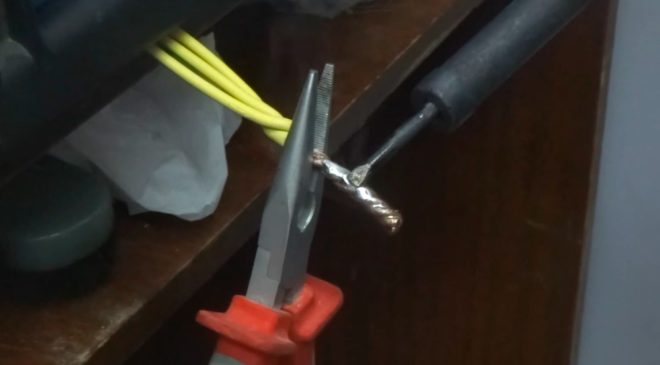
There are many ways to connect conductors. In this article, we'll talk about one of the most reliable ones - soldering wires with a soldering iron. This process is delicate and painstaking. If you have never held a soldering iron in your hands, then you will need to learn a little. First, you need experience and skills in the ability to use a soldering device. Secondly, before soldering the wires, you need to connect them into a twist. Third, you will need special tools and materials.
Content
Process physics
Before doing soldering wire connection, it would be nice to understand the very essence of this process.
With the help of rations, one-piece connections are obtained. For example, if you need to connect any two elements (cable or wire), then solder is introduced between them in the form of molten metal. It is necessary that the melting point of this metal is lower than that of the materials of the elements to be joined. The brazed element, flux and solder are brought into contact by heating. The solder becomes liquid and wets the surface of the conductor. When the heating is stopped, the solder alloy solidifies, thereby forming a strong contact joint.
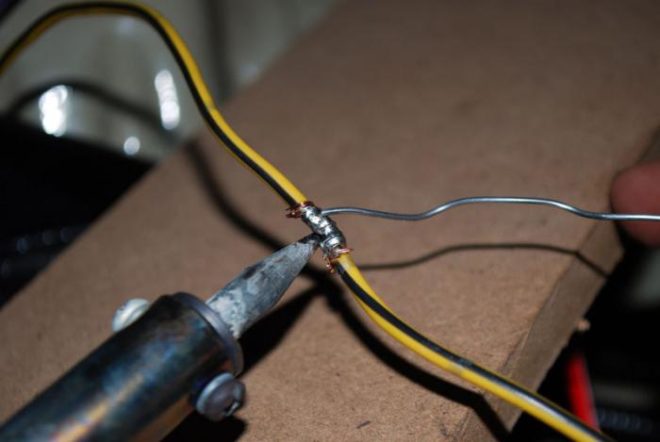
Contact strength depends on how well the solder has wetted the surfaces of the elements to be joined. And here there is a direct dependence on how clean these elements were at the time of soldering. Therefore, before soldering the wires, they must be free from organic matter (oil, grease) and from an oxide film. For this purpose, and it is necessary to use a flux, moreover, it lowers the surface tension and improves the quality of spreading.
The smallest requirements for flux, solder alloy and temperature are made by soldering copper wires. Therefore, if you want to learn such a thing, it is better to first solder copper wires with a soldering iron, and over time, when you gain skill and experience, you will work with other materials.
Advantages and disadvantages of soldering
The most important advantage of soldering over other types of wire connections is reliability. In terms of reliability, a welded electrical assembly can only be second only to a welded connection.
For the entire period of operation, you can forget about the soldered connection, it does not require any additional maintenance.
Using soldering, you can connect conductors of different cross-sections, single-core to stranded.
This method is classified as low in cost. The main thing is that you have a soldering iron, and solder with rosin are very inexpensive, while their consumption is very scanty.
Also, the undoubted advantage of soldering is that it can be used to simultaneously connect more than 2 wires.
The disadvantages of soldering include high labor intensity and the mandatory presence of skills in using a soldering iron.
Required tools and materials
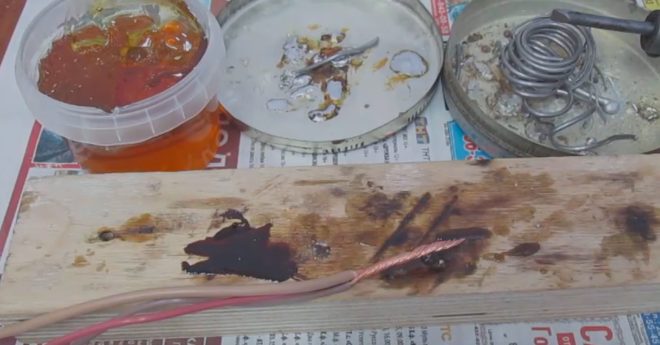
Before soldering the two wires, you first need to purchase all the necessary materials, and also stock up on the most important device - a soldering iron.
Soldering iron
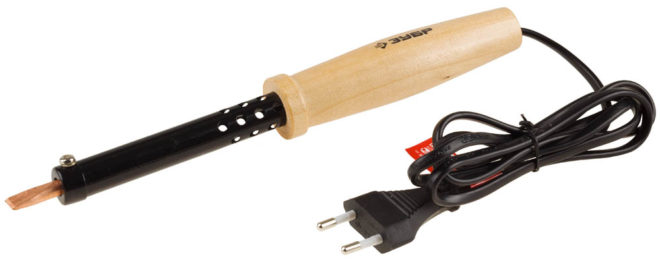
This device is a heating device, with its help the solder alloy and the surfaces of the parts to be soldered are heated. It has three main parts:
- handle (it is made of wood or plastic, it does not heat up during operation);
- a heating element;
- work item.
Soldering irons are of different types:
- Electric heating. The working part of such a tool is the tip of a copper tip, which is heated by a heating element.The temperature of the tip reaches 300 degrees, while it is not very powerful (from 60 to 100 watts).
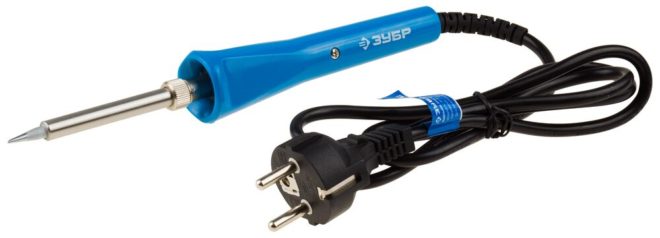
- Gas. By the principle of operation, this soldering iron is similar to an ordinary gas burner, the place where the soldering is to be done is heated with an open flame.
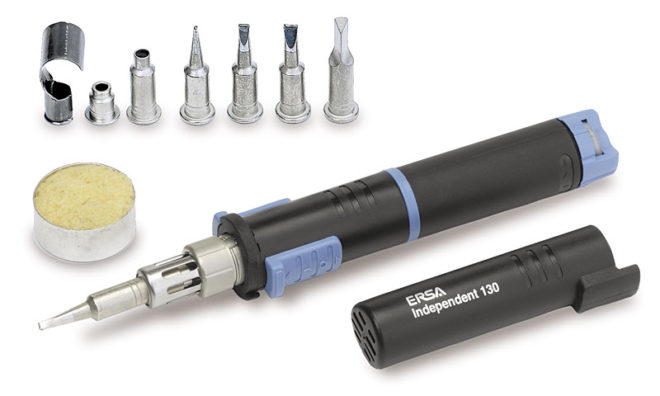
- Hot air. The place of soldering is heated with a descendant of hot air.
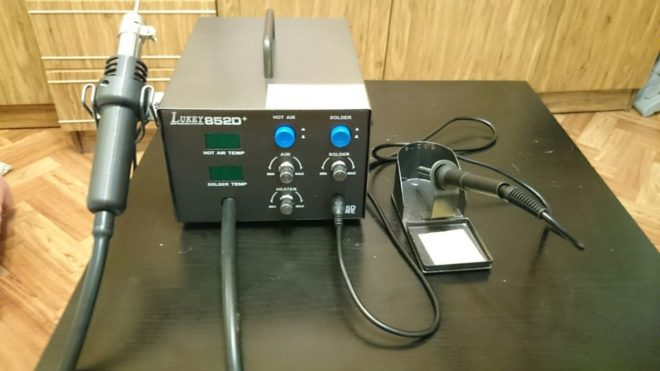
- Molotkovy. This soldering iron also has a copper tip, but in shape it resembles a massive hammer. Heating takes place using an open flame or due to a built-in electric heating element.

The most widely used electric heating soldering iron for soldering radio components and wires.
Solder
The main material in the soldering process is solder. It is an alloy of several metals, which has a lower melting point than the metal of the elements to be joined. Such alloys are made from tin, cadmium, silver, copper, lead, nickel.
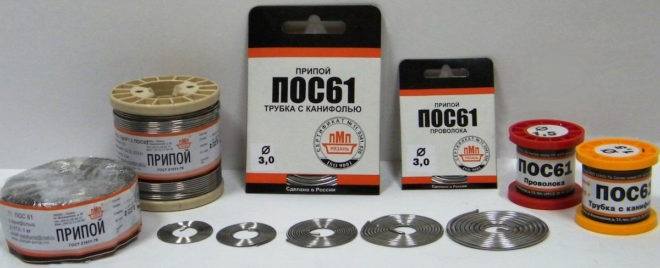
It is desirable to solder copper wires with an alloy of the POS-60 brand. The letters POS indicate that this solder is made of tin and lead. The numbers show how many percent of tin is contained in the solder. Of course, pure tin is considered the best solder material, but it is expensive, it is used in exceptional cases.
The form of release of solder is different - in granules, pastes, ingots, powder, foil or wire.
How to use solder alloy? It is heated above its melting point and, when it reaches a molten state, they touch the solid surfaces of the elements to be joined. At this moment, chemical and physical processes begin. The solder alloy spreads over metal surfaces, penetrating between them into all gaps.
Keep in mind! Before you can solder the aluminum wires, you need to find some special solder. For this metal, zinc-based alloys TsO-12 (zinc with tin) or TsA-15 (zinc with aluminum) are more suitable.
Flux
Most often, a mixture of organic and inorganic substances is used as a flux, with the help of which surfaces are prepared for soldering. It can be rosin, acetylsalicylic or phosphoric acid, ammonia or borax salt.

The most common flux is rosin. Some people use acid for brazing, but it is inferior in quality to rosin. Although it is much easier to use acid, we wet a brush in it and applied the substance to the surfaces to be joined. With rosin it is a little more difficult, you need to lay a core in it, heat it up with a soldering iron, then the resin will begin to melt and envelop the wires.
Sometimes solder is used, which is a thin wire filled with rosin inside. Of course, this makes the process faster and more convenient, it will only be enough to take solder with a heated soldering iron and apply it to the surfaces to be joined, there is no need to process each wire with rosin separately.
Other tools

Also, in order to make the soldering of the conductors, you will need:
- A place for work, it must be covered with a material that will not be afraid of drops of molten solder. A metal table or some kind of metal or wood support will do when work needs to be done, for example, in a junction box.
- Soldering iron stand (it must be reliable and convenient).
- A piece of damp cloth or a sponge for cleaning the soldering iron tip.
- File. Before using the soldering iron, you will first need to clean its tip, there should be no traces of carbon deposits on it, then the soldering will go easily.
- A knife or a special device for removing the insulating layer from the wires.
- Pliers.
- Sandpaper.
- Alcohol.
- Insulating tape (or heat-shrinkable tube).
Preparatory work
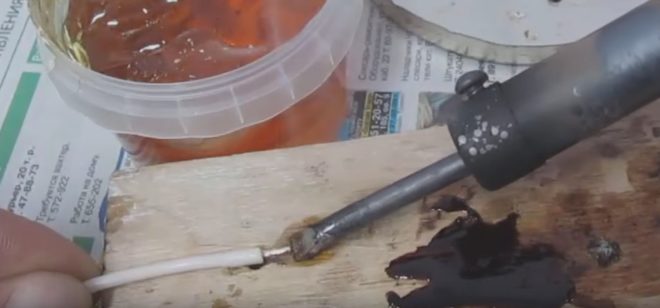
Before soldering the wires, a number of preparatory work must be done:
- Cut off the insulating layer on the conductors to be connected by 40-50 mm.
- Now you need to clean the bare areas from the oxide film.This can be done with fine sandpaper. The conductors of the wires must be stripped to a shine.
- Before soldering copper conductors, they are tinned. Heat the soldering iron to the melting point of the rosin. How to find out? Just touch the rosin with the tool, it will begin to actively melt. Immerse the exposed area in rosin resin. Take some solder alloy with a tip and run it along the wire. To make the process smoother and faster, twist the wire a little. After tinning, the copper core will not turn red, but silver. Do the same for all wires that need to be soldered.
- Connect the tinned wires into a twist.
How to perform tinning of wires is shown in this video:
Now everything is ready for the soldering process itself.
Soldering
Use one hand to hold the twisted wires with pliers. If you connect only two thin wires, and the soldering length is small, then it is quite possible to do without twisting. It is only necessary to very tightly attach the conductors to each other. In the other hand, take a soldering iron preheated to the required temperature and type the solder alloy with a sting. Press it to the junction with a little pressure. Warming up should occur in this place, the rosin will boil and the solder alloy will begin to spread. It only remains to wait for the alloy to spread and fill all the gaps between the veins.
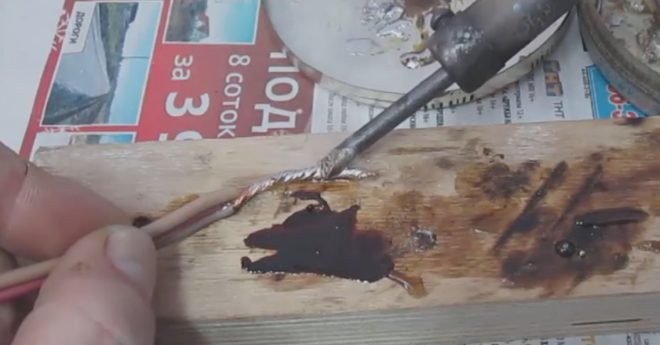
It is very important that the surfaces to be joined are well heated. Because if the solder hardens and does not wet, the result is a flimsy soldering, which electricians call "cold" or "false".
It is imperative to let the solder cool down while stationary. Even the smallest movement of the elements to be brazed at the moment of solidification of the solder can affect the quality and strength of the joint.
When the solder is solidified, wipe it with alcohol to remove any remaining flux.
How to properly solder is shown in detail in this video:
and here you can see how to solder a twist in conditions close to real:
It remains only to reliably insulate the connection. You can wind 3-4 layers of electrical tape. A heat-shrinkable tube serves as good insulation. Just remember to put it on one of the conductors before starting the connection. Then pull it over the resulting electrical unit, heat it with a hair dryer or lighter, and the tube will tightly grip the connection. The second option is preferable, since it provides tightness to the contact connection.
We've told you how to properly solder the wires. In principle, this is not difficult for those who know how to use a soldering iron. If you have never done this, it is better to ask someone to teach you a little. Of course, you can read in the articles and theoretically understand everything. But do not forget that "it is better to see once."




